The post,
Bilharzia infections plague Limpopo schools, first appeared on WWMP .
Bilharzia infections plague Limpopo schools
Limpopo learners and their parents are living in constant fear of being infected with bilharzia as the deadly disease plagues public schools in Limpopo. In recent weeks, more than 155 positive cases of bilharzia have been reported in Limpopo across various schools, more especially in the greater Tzaneen area.
While the root cause behind the sudden outbreak remains unknown, poor sanitation and a lack of clean running water in Limpopo communities has been fingered as the likely cause behind the outbreak of bilharzia by parents and learners.
According to the World Health Organisation (WHO), bilharzia is an acute and chronic parasitic disease caused by blood flukes of the genus Schistosoma. It enters one’s skin through infected bodies of water. Though there is no known vaccine to prevent bilharzia, there are drugs to treat the condition. But if the condition is left untreated, it can lead to bladder cancer and other deadly medical conditions. WHO estimates that at least 251.4-million people globally required preventative treatment against the disease in 2021. Bilharzia infections are more prevalent in poor communities without potable water and sanitation.
With over 1,400 public schools in Limpopo still making use of dilapidated pit toilets, while several still do not have running water, Elitsha spoke to parents and learners of some of these schools.
Rotshidzwa Maluga is a chairperson of the school governing body at Mabila Primary School, which does not have running water and was only supplied with six mobile toilets in August this year, putting an end to the use of dangerous, dilapidated pit toilets. “Everyday, I pray that the bilharzia virus does not reach our community and the school, because if it does, it is bound to spread throughout the school as we do not have running water at the school premises and even in our villages. It is a scary situation for us, not only for local schools but for the whole community at large. We just keep on praying and hoping for the best,” says Maluga.
Maluga says that without piped water, they resort to using unpurified water from the local river, where learners often also play after school. “Our other worry is that as learners and other members of the community continue to use water from the local river to wash their clothes, collect water to bath and to also do other household chores, if it happens that the virus reaches the local river, we are all bound to be infected with bilharzia,” says Maluga.
Neil Shikwambana is the provincial spokesperson for the Department of Health in Limpopo. He contends that there is not an outbreak of bilharzia and that the 156 confirmed cases of bilharzia is rather a result of increased testing. “We are awaiting more laboratory test results, but we think the situation is under control, because if you look at the ratio of testing versus positive cases, you will realise that there isn’t a spike,” he says.
But Shikwambana says that they remain unsure of the root causes behind the bilharzia cases in the province: “The water service authorities are still seized with the task of determining the exact source”. According to Equal Education (EE) head in Limpopo, Zanele Modise, the use of dilapidated pit latrines in the province is the critical concern. She says that the Department of Education is failing its learners by not putting enough effort into eradicating pit latrines at Limpopo public schools.
Zwidofhela Masindi is a parent to a 10-year-old learner at a public school outside of Thohoyandou. She does not know much about bilharzia, but fears the unsanitary conditions at the school. “The school where my child goes to does not have any form of running water and they also continue to use pit toilets and I am very sure that after using the toilet they have nowhere to wash their hands. This makes me to live in fear as I am always worried that if bilharzia spreads to the school, my child will also be affected,” says Masindi.
She wishes that the relevant government departments step up their efforts in ensuring that bilharzia does not spread further. “This should serve as a warning to the Department of Education that each school is supposed to have proper toilets and running water, because if they had water and proper sanitation at this stage we would not be worrying about the health of our children,” says Masindi.
Justice Chauke* is a grade 11 learner at Waterval High, outside of Elim which is faced with a critical shortage of water. He says that they have to share limited pit toilets. “I have heard reports of a bilharzia outbreak on the local radio station and what first came to my mind was that, if they are saying that lack of water and poor sanitation can lead to the spread of the disease, we are bound to suffer as Waterval High learners as the school does not have proper toilets nor running water,” says Chauke.
Mosebjane Kgaffe is the spokesperson for the education department in Limpopo. She says that they are working together with the provincial department of health to ensure that bilharzia does not spread further within schools in the province.
Limpopo health MEC, Dieketseng Mashego has set up a task team compromising of representatives from the office of the premier, and the departments of basic education, health, human settlements, and cooperative governance and traditional affairs to conduct tests within schools and communities. “By identifying cases of bilharzia early, we can provide treatment and prevent further spread of the disease. We are working with the local water service authorities to conduct water quality tests as one way of preventing the disease because as much as screening, testing and treatment is important, it is even more important to work towards prevention,” says Mashego.
* Not their real name






